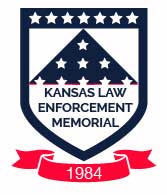Criteria for Inclusion
In 1984, the Kansas Legislature established the Kansas Law Enforcement Memorial. K.S.A. 75-2250 and K.S.A. 75-2251 provide statutory authority for the memorial and an advisory committee. The memorial, located on the grounds of the state capitol, is a tribute to law enforcement officers who have lost their lives in the line of duty while in service to the state. The guiding principle for inclusion on the memorial is to honor those, who by virtue of their commitment to uphold the law and protect the citizens of Kansas, gave their lives in service to the people of this state. Therefore, the criteria set forth here are to insure that the memorial continues to be a tribute to those who were killed or died as a result of a law enforcement action or emergency situation.
For the purpose of this memorial, “law enforcement officer” means an individual involved in crime control reduction and who is directly employed on a full-time, part-time, or volunteer basis by a local, county, state, or federal law enforcement agency, with or without compensation, who is duly sworn and has full arrest powers. In addition, military police officers will be included only if at the time of their death they were performing duties similar to those of non-military law enforcement officers.
Correctional employees shall be included if they are recognized as having law enforcement status by their employing jurisdiction. Other correctional employees who do not have formal law enforcement status, but do have a primary or limited responsibility for the custody and security of suspected or convicted criminal offenders, and are employed by a local, county, state, or federal correctional agency, will also be considered. If law enforcement is not a person’s primary function, then that person must be engaged in their law enforcement duties when the fatal injury occurs. In such cases, eligibility will be determined after a review of several factors, including but not limited to job description, federal, state or local statutes, training, and circumstances of death.
“Line of duty” means any action which an officer is obligated or authorized by law, rule, regulation, written condition of employment service to perform, or for which the officer is compensated by the public agency he or she serves.
The term “killed in the line of duty” means a law enforcement officer who has died as a direct and proximate result of a personal injury sustained in the line of duty. This includes victim law enforcement officers who, while in an off-duty capacity, act in response to a law violation, or are actually en route to or from a specific emergency, or responding to a particular request for assistance.
Accidental deaths resulting from training activities will be considered for inclusion after a review of several factors, including, but not limited to, the circumstances of death, type of activity, and whether or not the training was authorized by the employing jurisdiction.
Not included under this definition are deaths attributed to natural causes, except when the medical condition arises out of physical exertion, while on duty, and directly related to a specific stressful response to a violation of law or an emergency situation. Included are deaths that occur within 24-hours of the stressful response, or during a continuous period of hospitalization immediately following the specific stressful response to the violation of law or emergency situation. Stressful responses include but are not limited to the following: 1) a physical struggle with a suspected or convicted criminal; 2) performing search and rescue that requires rigorous physical activity; 3) performing or assisting with emergency medical treatment; 4) responding to a law violation or emergency situation that involves an imminent risk of serious injury or death to the officer or others; or 5) a situation that requires either a high speed response by vehicle or pursuit on foot. Specifically excluded under this definition are medical related deaths resulting from training, deaths attributed to voluntary alcohol or controlled substance abuse, deaths caused by the intentional misconduct of the officer, deaths caused by the officer’s intention to bring about his or her own death, and deaths attributed to an officer performing in a grossly negligent manner at time of death.
Deaths caused by disease will be reviewed by a qualified pathologist or other medical personnel with similar skill and expertise. If it is determined that the officer died as a result of infectious disease contracted while performing official duties, or by exposure to hazardous materials, or conditions while performing official duties, that officer is eligible for inclusion on the memorial.
An officer will be included if the employing jurisdiction states that the officer died in the line of duty and there is insufficient credible information to believe otherwise. When there is unresolved doubt regarding the circumstances of the officer’s death or with respect to status as a law enforcement officer, the matter will be resolved in favor of inclusion. The Law Enforcement Officers Memorial Advisory Committee, the Director of the Kansas Bureau of Investigation, and the Kansas Historical Society will exhaust all reasonable means available to verify an officer’s eligibility status.
Adopted by the Law Enforcement Officers Memorial Advisory Committee
